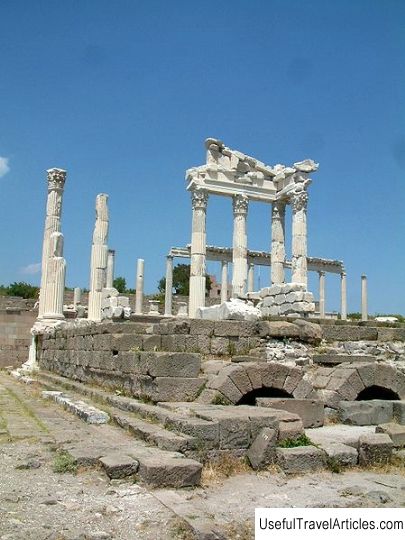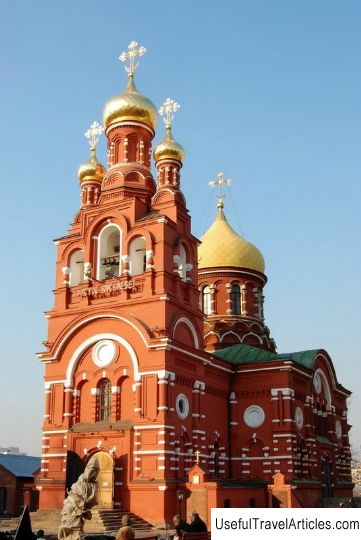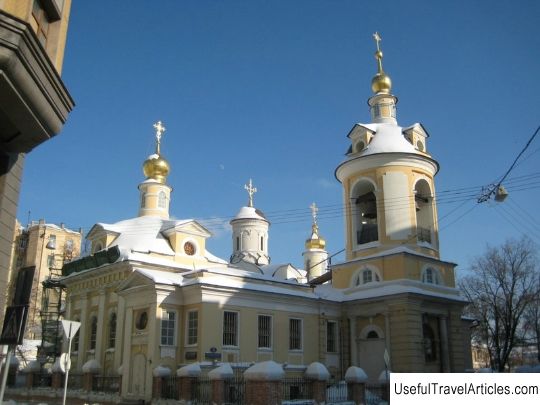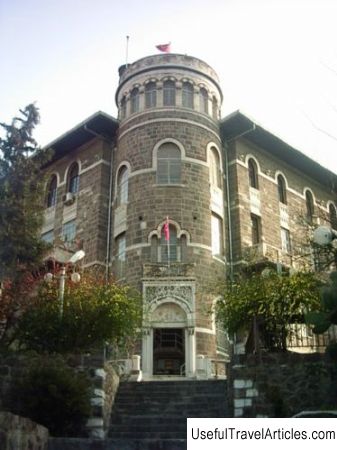Ruins of the city of Pergamon (Pergamon) description and photos - Turkey: Bergama
Rating: 8,6/10 (523 votes) 
Pergamon ruins description and photos - Turkey: Bergama. Detailed information about the attraction. Description, photographs and a map showing the nearest significant objects. The name in English is Pergamon. Photo and descriptionThe ruins of the ancient city of Pergamum, once the legendary capital of the Pergamon kingdom, lie at a distance of 1.5 kilometers from the modern Turkish city of Bergam, which is located in the province of Izmir. According to ancient Greek myths, the city was founded by the son of Andromache and Helen (brother of Hector, the first husband of Andromache), named Pergamum after the Trojan citadel, which was called Pergamum. The ancient city was located on the coast of Asia Minor and was founded in the XII century BC by immigrants from mainland Greece. In 283-133 BC, it was the capital of the Pergamon kingdom. The city reached its highest prosperity under Eumenes I (263-241 BC) and Eumenes II (197-159 BC). It was one of the largest economic and cultural centers of the Hellenistic world and one of the earliest centers for the spread of Christianity. In the III century, the settlement was captured by the Goth tribes, and in 713 it was destroyed by the Arabs. Later the city was rebuilt by the Byzantines, but nevertheless gradually fell into decay and in 1330 it was captured by the Turks. Since then, the buildings of the city, abandoned by the inhabitants, gradually collapsed until the earth swallowed them almost completely. Only at the end of the century before last, archaeologists excavated and returned to mankind samples of antique architecture and sculpture, which enriched the expositions of some museums in the world. Until the beginning of the 20th century, the inhabitants of the city of Bergam, dug out in their sites, pieces of marble with traces of sculptural images were burned on lime. They didn't even know that live on the ruins of the great city of the ancient world. The peasants learned about its existence only in 1878. In that year, the German engineer Karl Human was invited to Turkey by the Sultan to build bridges and roads. Starting construction, the German engineer discovered one of the most interesting monuments of Hellenistic art - the huge altar of Zeus. Many large fragments of slabs with reliefs have been preserved under the layer of earth. Many valuable finds of Pergamon are now in Berlin in the Pergamon Museum, as well as in the Archaeological Museum of Bergama. In ancient times, Pergamum was the third largest city after Rome and Alexandria. He owed his wealth and fame to trade, the presence of the most fertile lands on which olives, grapes, bread were grown, and successful selective animal husbandry. Gold brocade was produced in Pergamon itself, thin linen and fragrant oils. The city became famous for its magnificent architecture, a huge library that rivaled the Alexandrian one, the museum of sculpture, scientific schools and the largest center of theatrical art. Today we can plunge into the atmosphere of this ancient city and inspect its ruins. Some of the structures have been fairly well preserved. The Acropolis was located on a hilltop, where the remains of some private houses, civil structures and temples were found. It is here that the world famous Library is located, dating back to the second century BC, during the reign of Eumenes II. It was famous for the over 200,000 precious parchment scrolls that it contained. In size, it was second only to the Library of Alexandria in Egypt. The constant rivalry between them led to the fact that the ruler of Egypt, Ptolemy, prohibited the export of papyrus from the country - at that time the main material for the production of books. Competitors in Pergamum had to think of an alternative writing material, and they began to use a specially crafted calfskin called parchment, and have been using it for writing for centuries, along with papyrus and other materials. Later, the Pergamon Library was destroyed, and numerous manuscripts were taken to Alexandria by Mark Antony. For some time, the Pergamon Library was led by the scientist Krates Malossky, who is famous for being the first to put forward a hypothesis about the location of four land masses on the surface of the spherical Earth, separated by strips of oceans. In the years 168-165 BC. he made a globe on which he marked four land masses, symmetrically located in relation to each other. On the terrace overlooking the ruins of the Library are the ruins of the Temple of Trajan, erected between 117 and 118 AD. The beautiful structure was built in honor of the emperor, who was ranked among the host of the gods. There are columns along the perimeter of the temple: six in width and nine in length. The building is designed in Corinthian style. It contained a sculpture of Emperor Trajan and a statue of his successor Hadrian, during which the construction of the temple was completed. Archaeologists have discovered the ruins of another grandiose temple - the Temple of Athena. The main entrance to the temple has been meticulously restored and exhibited in the Berlin Museum, where you can also see the magnificent temple portico with a graceful, lightweight double colonnade. This temple was built in the 3rd century BC. and was originally decorated with Doric bas-reliefs. The perimeter of the temple is surrounded by the same number of columns as the Temple of Trajan. Near the theater is the Temple of Dionysus, built in the 2nd century BC. and rebuilt by Caracalla after a fire that destroyed the original structure. In the II century BC, in honor of the victory over the Galatians, a large marble altar of Zeus was erected. The ruins of the altar were brought to Berlin and professionally reconstructed there. Today they are kept in the Pergamon Museum. The altar used to be a platform of snow-white marble, three walls of which were decorated with a marble relief ribbon. A staircase on the fourth wall led to a pillared platform with a marble altar in the center. Together with the altar, a magnificent frieze was also transported to Berlin, which depicts the battle of the gods with giants. The reliefs of the frieze are rightfully considered the best sculptural masterpieces of Pergamum. Among the rest of the structures located around the Acropolis hill, ancient baths and gymnasiums attract attention. The latter was an educational institution for noble youth and was erected at different levels connected by underground passages and wide staircases. The monumental ruins of the Red Basilica, otherwise called the Red Court, rise at the base of the castle hill, near which the river flows Bergama Caik. This name of the temple is explained by the bright red color of its brick walls. Both underground galleries of the building served as a channel for the waters of ancient Selinus. The temple was built in the second century under Hadrian and is dedicated to the cult of Serapis. During the period of Byzantine influence, the temple was transformed into a basilica. The Sacred Road, once surrounded by columns, leads to the ruins of Asclepium, without doubt the most famous temple of Pergamum. The building is dedicated to the cult of the healing god Aesculapius and existed even before the arrival of the Romans. The building was founded in the fourth century BC and was a Pergamon hospital. The inscription on it read: "In the name of the gods, death is prohibited." Patients were treated here with healing waters, took baths in bronze pools, entrusted their bodies to skilled masseurs, who, with the help of fragrant rubbing, gave their former strength to their weakened muscles. The patients were resting on stone benches located in the galleries of the health resort. Under their arches were hidden openings through which the voices of invisible psychotherapists were heard. They advised patients to forget about their ailments and sorrows, not to think about physical suffering, to suppress the disease with the strength of their spirit. Thanks to this, the doomed had hope for healing and their body itself coped with the disease. According to written sources, the founder of the Pergamon hospital was a citizen named Archias. The local physician Galen, who became famous for his unsurpassed eloquence, was especially famous as a healer in the II century BC. At first he used the “method of self-hypnosis” to treat only gladiators, and then all those who needed help. Patients came to him from all parts of the world, and gradually Asklepion turned into a small city with several temples and a hall for medical consultations.        We also recommend reading Church of Michael the Archangel description and photo - Russia - Siberia: Novosibirsk Topic: Ruins of the city of Pergamon (Pergamon) description and photos - Turkey: Bergama. |




